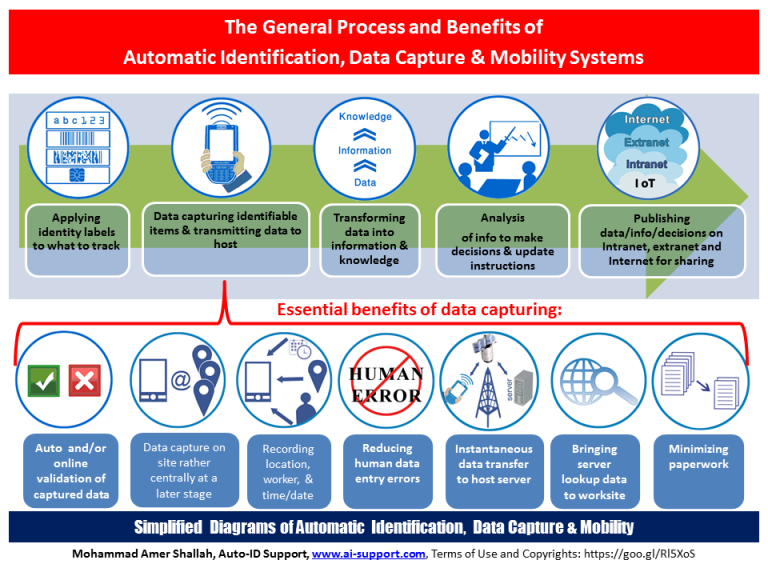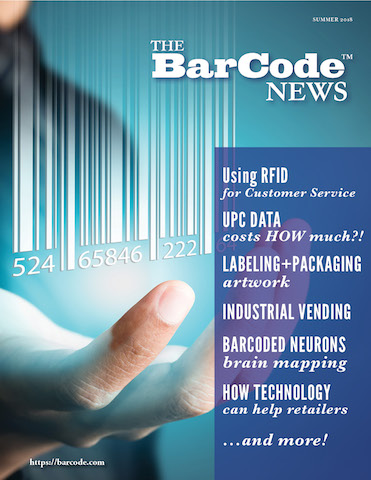The General Process & Benefits of Auto-Identification Systems
This diagram shows the comprehensive benefits of AIDC systems and is generally broad to cover widest range of devices and applications (although a simple SYSTEM could consist of a simple HARDWARE device like a barcode reader and a simple SOFTWARE application like Excel sheet). Assuming an express delivery shipping company is using an AIDC system, it would be the example to build on - see below.
Mainline benefits:
1- Applying identity labels to what to track
Tracking people, documents, vehicles, or goods requires applying machine readable identification labels (badges for people, barcodes printed on documents, RFID tags on windshields and so on). In addition to machine readable data on the labels, the printed text information also make it clear to human readers. Express shipping companies apply sequential barcodes to airway bills (AWB) and apply labels to documents and/or boxes for their frequent data collection of shipments all the way from sources to destinations. There are cases where no labels are involved; it involves an inherent property such as fingerprint template of a person.
2- Data capturing identifiable items & transmitting data to host:
This is the major step to avoid human data capture errors and replace them with accurate machine readable data. AWB data for example is scanned directly to a PC or scanned/stored by portable handheld PDA devices, transmitted later in batch or continuously online.
This is the essential step that reflects the essential advantages of AIDC:
a- Automatic and/or online validation of captured data:
Any scanned data not within range of expected values causes an alert to the operator. Eg, an expired AWB# reflects immediately that it cannot be used.
b- Data capture on site:
The great advantage in using mobility devices is that data capture is done on site. For example, scanning of AWBs is done at delivery locations rather than feeding back handwritten forms when returning to office.
c- Data capture of site location, operator name and date/time stamps:
Workers delivering shipments can scan their deliveries using handheld devices. Handheld devices record the site of scanning (using GPS coordinates or fixed location barcodes), worker names as well as time and date stamps.
d- Reducing human data entry errors and time:
When the data capture device records a scanned item its location, date and time are automatically captured. Human data entry errors are eliminated and there are time savings.
e- Instantaneous data transfer to host server:
Many modern AIDC devices are able to communicate with their data servers for data synchronization using different methods of communication such as Wifi (within working premises), cellular (while on the road) and even via satellite (in remote and travel locations).
f- Bringing server data lookup to work site:
A handheld device, for example, can communicate to the host data server and obtain lookup data needed at site of work such as the past history of an AWB.
g- Minimizing paperwork:
Most paper forms can be turned into forms on PDA device screens to collect the data electronically rather than filling by hand manually.
3- Transforming data into information & knowledge:
Machine readable data collected by AIDC devices are stored in data tables. Data tables are transformed into information and statistical layouts related to application types. Eventually, information of all levels of work forms a large knowledge base about the transaction activities.
4- Analysis of info to make decisions and update instructions:
Data, information and knowledge are analyzed so that decisions are made after evaluating the performance and efficiency of transactions. An express shipping company can extract reports on late deliveries then analyse the causes and relate them to specific people or locations.
5- Publishing data/ info/ decisions in Intranet, Extranet and Internet:
Collected data is made available to those it concerns. For example, shipment tracking data are made publicly available on the internet for customers to track and locate their consignments. Customer invoices of shipments are stored in extranets, while detailed collected data on shipping transactions remain stored on the intranets of the shipping companies for the logistic operations.
The diagram can help:
- AIDC manufacturers, specialists, distributors and integrators have a broad vision of what they are designing, developing, and selling and see how efficient their solutions would be.
- Software developers design their data capture applications in most efficient way to customers.
- AIDC resellers explain to their customers the benefits, the overcoming of difficulties and cutting of costs.
About myself and my writings:
I have been implementing automatic identification, data capture technologies, and mobility for over 20 years in domains of manufacturing, retail, logistics, government and security. The accumulated experience and continuous follow up on latest emerging technologies help me to contribute writings about current trends and highlight challenges. I try to bring up diagrams, infographics, and cartoons alongside each topic to clarify concepts in a simple way. I welcome all comments.
This diagram is GENERIC and educational. It is not biased to any specific technology, supplier or brand. It can help any salesperson to explain general neutral concepts to prospects. It can also help the customers to realize what to expect from these systems.
Mohammad Amer Shallah, Auto-ID Support, www.ai-support.com
Terms of Use and Copyrights: http://bit.ly/2mj2ZUj
#
The Bar Code News (www.barcode.com), now in its 9th year, does not sell software, hardware, bar code products or services and we rely on sponors to stay in business. Use the links on the left side menu to find the products or services you need. Want to reach us? See the links on the Footer menu below. Please let vendors know you’ve seen them here.
The Barcode News Magazine :: Summer 2018
We invite you to read our online magazine issue. Click to read the latest in barcoding!
This issue features articles and case studies on:
- Using RFID for Customer Service
- The True Cost of UPC Data
- Labeling and Packaging Artwork
- Industrial Vending
- Barcoded Neurons and Brain Mapping
- How Technology Can Help Retailers
- and more...


